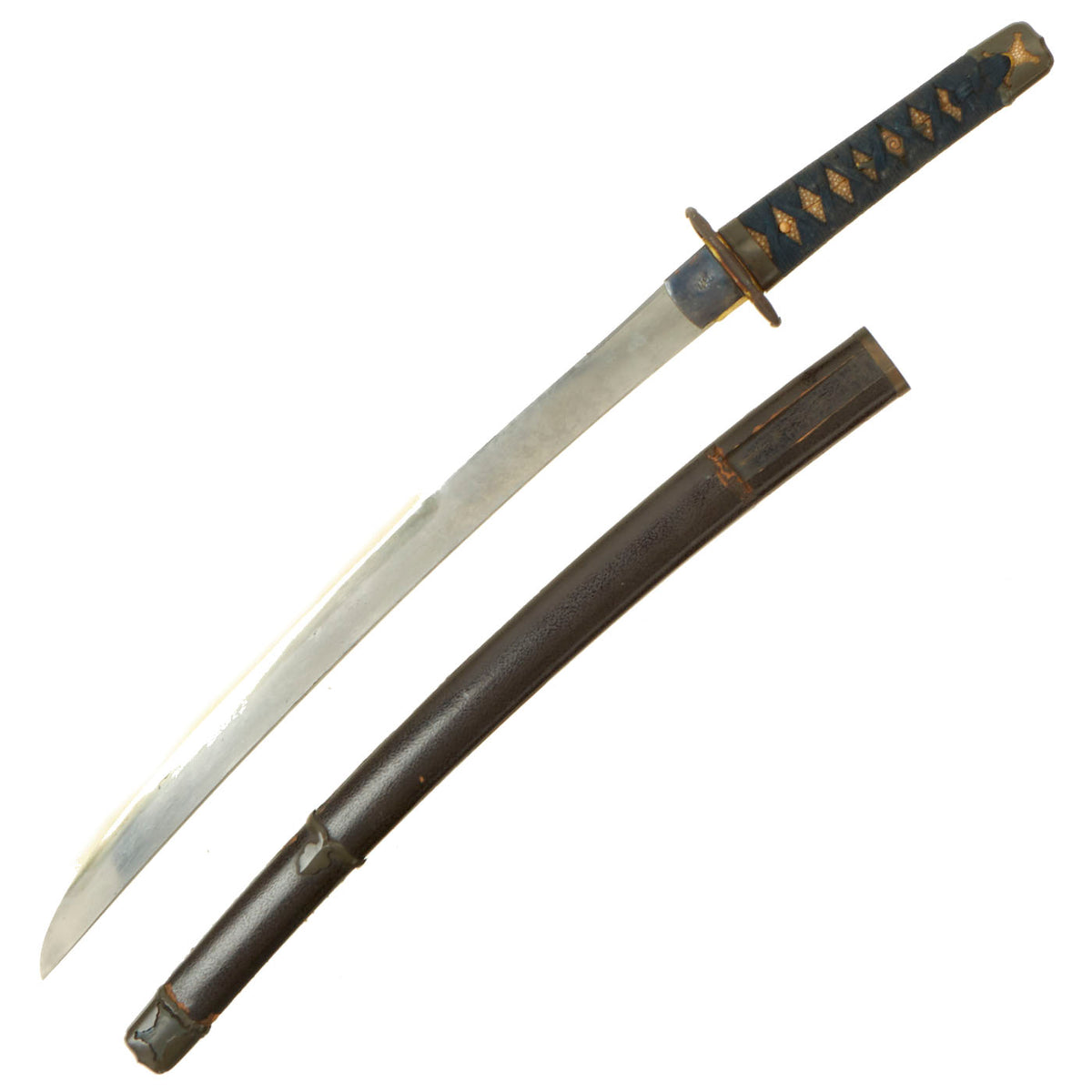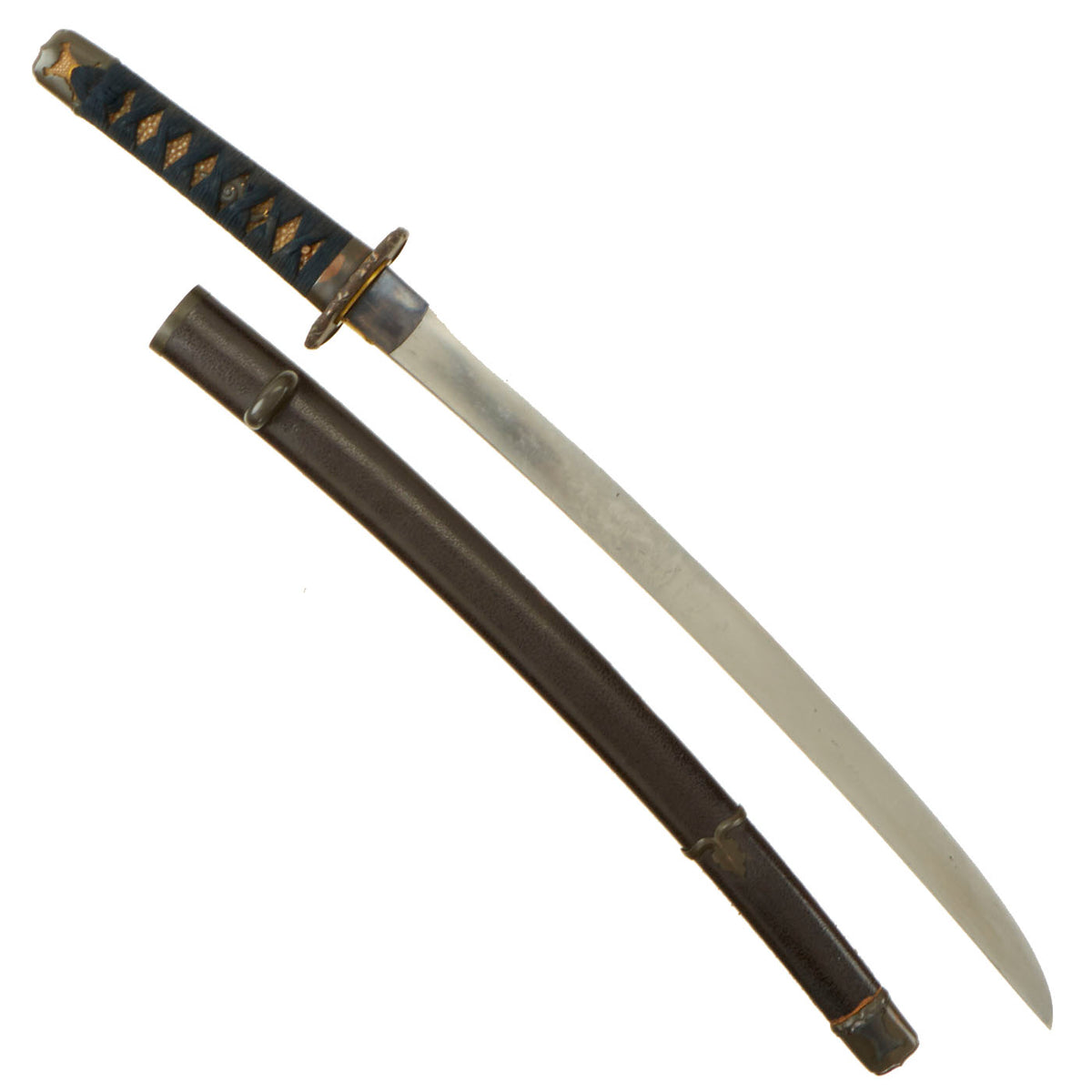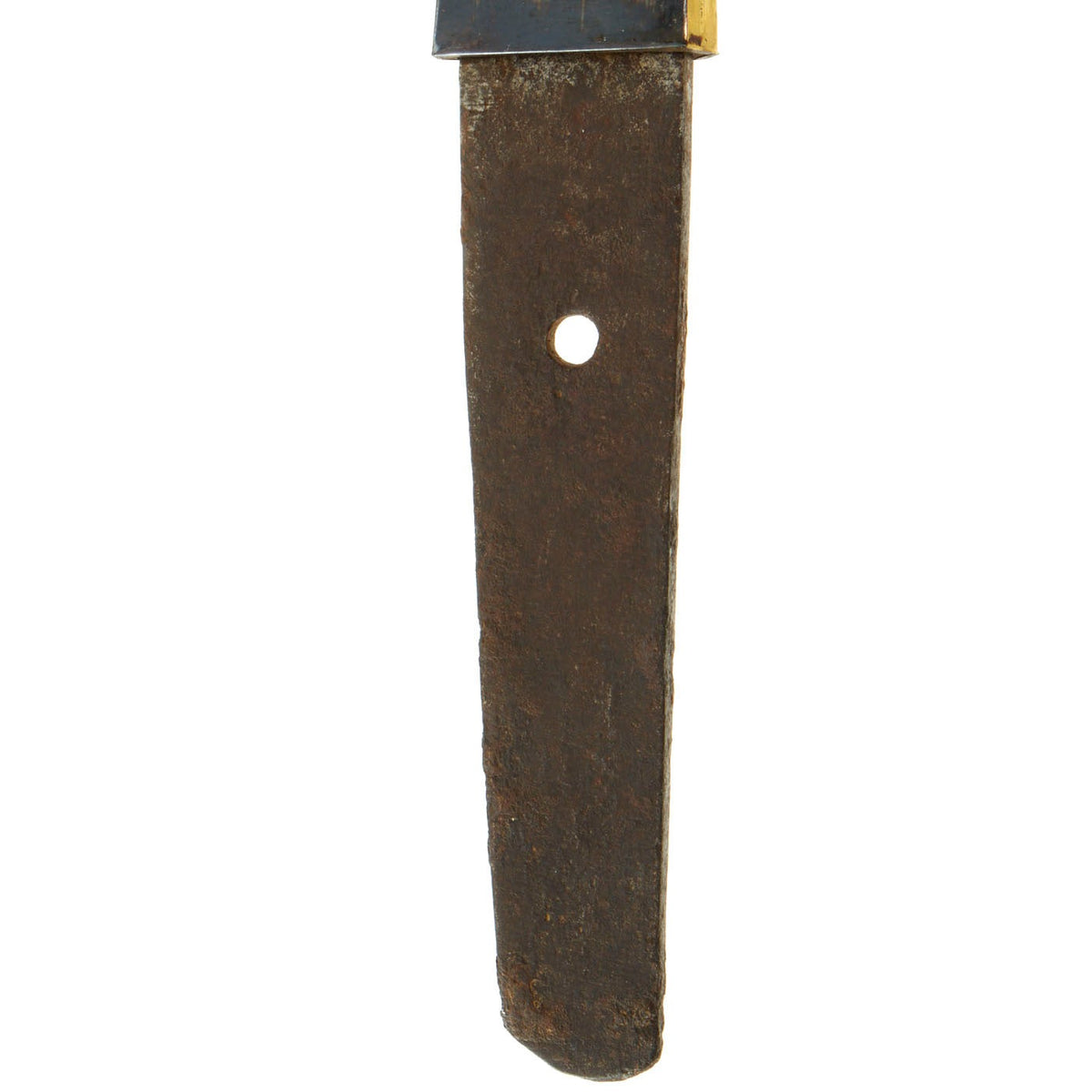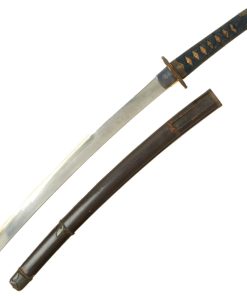Original 15th Century Muromachi Period Japanese Wakizashi Short Sword with Lacquered Scabbard c. 1450 Original Items
$ 1.695,00 $ 423,75
Original Item: Only One Available. Wakizashi (脇差 “side inserted / companion sword”) is a general term for a sword with an edge between one and two shaku long (30 cm and 60 cm), predominantly made after 1600, though there are many example from earlier. Generally it is the short blade that accompanies a katana in the traditional samurai daisho pairing of swords, but may be worn by classes other than the samurai as a single blade, also worn edge up as the katana.
We had this sword examined, and we believe this example dates from the Muromachi period (室町時代 Muromachi jidai) of 1336 to 1573, during the middle circa 1450. This is part of the period of Japanese swordmaking known as Kotō (古刀”old swords”), the the type of swords that later smiths treated as the goal they needed to achieve. The fittings may be of later manufacture, but are still centuries old. Characteristics of the blade are distinctive of Bizen Province (備前国 or Bizen-no kuni), a major sword making center in feudal Japan.
This example has most likely been remounted several times, as was common for Japanese blades. The tang no longer shows any of the file marks (yasuri-me), and is covered with a lovely worn oxidized patina. It is possible that it at one time had a maker marking, but it would have worn off long ago. As there is no maker name visible on the tang, this blade is considered 無名 (mumei), or “anonymous”.
The blade has the following period correct features:
– Folded steel blade (fold lines are evident on the spine and body of the blade)
– hole in the tang is punched and not drilled
– blade has a temper line (hamon), as well as clear lamination activity.
– Blade wounds (kizu) or lamination artifacts are present on the blade. Both ware (lamination lines) and fukure (carbon pits) are visible.
The blade of this example is 17 5/8 inches long, and the polish on the blade is fair, overall showing cleaning and use since the last time it was fully polished. Overall length of this wakizashi is 25 1/2 inches. The blade shape is HIRA-ZUKURI, which means that it does not have a SHINOGI (Blade ridge). This is a shape used on shorter Wakizashi as well as many Tanto knives. Some would term this is a Ko-Wakizashi as it is shorter, and very much resembles a long tanto.
The hamon (temper line) is still visible in the light, and is of the GUNOME MIDARE (Irregular zig zag) type, with a lot of activity. Nie Crystals are visible, and there is Nioi cloudiness visible with lamination lines. The tang (nakago) is of the futsu 普通 (regular) style, with a Haagari (asymmetrical rounded) nakago-jiri. The body of the blade shows faint MOKUME (Wood burl) Hada (grain), and unfortunately the BOSHI type is not discernable due to the polish condition. There are blade wounds including ware (lamination splits) and fukure (Carbon pits). This blade would most certainly come alive with a professional finish polish.
The tsuba (cross guard) is made of iron and is a less common octagonal shape shape, with inlaid silver plated copper designs on the “left” side. There is a Kozuka Hitsu-ana for a Kogatana knife on one side, and there are three seppa (spacers) around the tsuba. The fuchi (collar) for the tsuka (handle) browned brass, as is the Kashira (End Cap), and both are of a simple design. There are two lovely gold highlighted bronze snail menuki present. The stingray (Sa-Me) grip with complete Ito (cloth binding) shows light wear, but is still in good condition. The handle is held on by a single peg (mekugi) which is certainly a replacement, but still quite old.
The sword comes in a a well fitting textured black lacquer wooden scabbard (saya), which has a cutout for a kogatana knife, which is unfortunately absent. The scabbard is in good condition, with some missing finish along the seams, where the scabbard has split on the glue joint. It has a kurikata (knob) where the sageo (sword cord) would be attached, which is in very good condition.
A great mid Muromachi Peroid wakizashi, complete with scabbard and ready to display!
Specifications:
Blade Length: 17 5/8″
Overall length: 25 1/2“
Scabbard Length: 19″
It has been over one thousand years ago that the art of making swords appeared in Japan. The swordsmiths of the time may not have known it but they were creating a legendary sword. The Samurai sword has seen combat in many battlefields. From the early days of the Samurai warrior to the fierce battles in the South Pacific during WWII.
Each hand-made Japanese blade (日本刀 – Nihonto) is unique because it is forged from multiple pieces of folded steel stock. A tremendous amount of work is dedicated to creating these pieces. They were an instrument of war as much as a beautiful artifact to adorn a room.
The traditional Japanese blade and mountings have grown to be one of the most highly desired military antiques.
Fast Shipping with Professional Packaging
Thanks to our longstanding association with UPS FedEx DHL, and other major international carriers, we are able to provide a range of shipping options. Our warehouse staff is expertly trained and will wrap your products according to our exact and precise specifications. Prior to shipping, your goods will be thoroughly examined and securely secured. We ship to thousands clients each day across multiple countries. This shows how we're dedicated to be the largest retailer on the internet. Warehouses and distribution centres can be located throughout Europe as well as the USA.
Note: Orders with more than one item will be assigned a processing date depending on the item.
Before shipping before shipping, we'll conduct a thorough inspection of the items you have ordered. Today, the majority of orders will be delivered within 48 hours. The delivery time will be between 3-7 days.
Returns
The stock is dynamic and we cannot completely manage it because multiple stakeholders are involved, including our factory and warehouse. So the actual stock may alter at any time. It's possible that you may not receive your order once the order has been made.
Our policy is valid for a period of 30 days. If you don't receive the product within 30 days, we are not able to issue a refund or an exchange.
You can only return an item if it is unused and in the same state as the day you received it. You must have the item in its original packaging.
Related products
Uncategorized
Uncategorized
Uncategorized
Uncategorized
Uncategorized
Uncategorized
Uncategorized
Uncategorized
Uncategorized
Uncategorized
Armoured Fighting Vehicles of the World: AFVs of World War One (Hardcover Book) New Made Items
Uncategorized
Uncategorized
Uncategorized
Uncategorized
Uncategorized
Uncategorized












































































